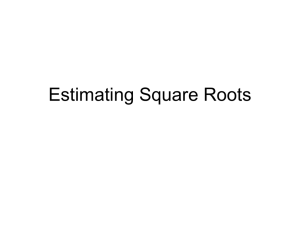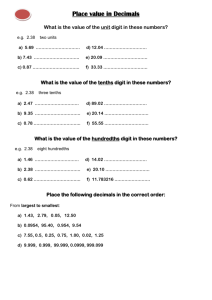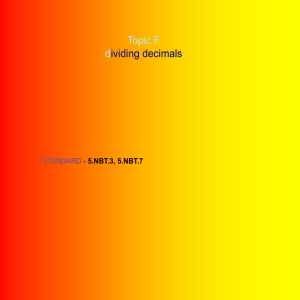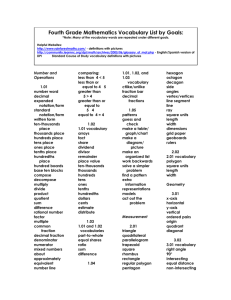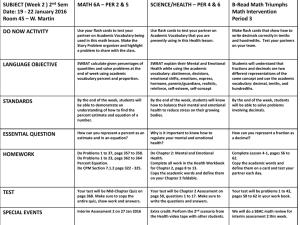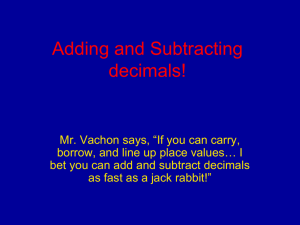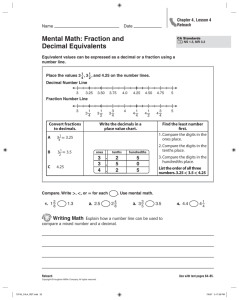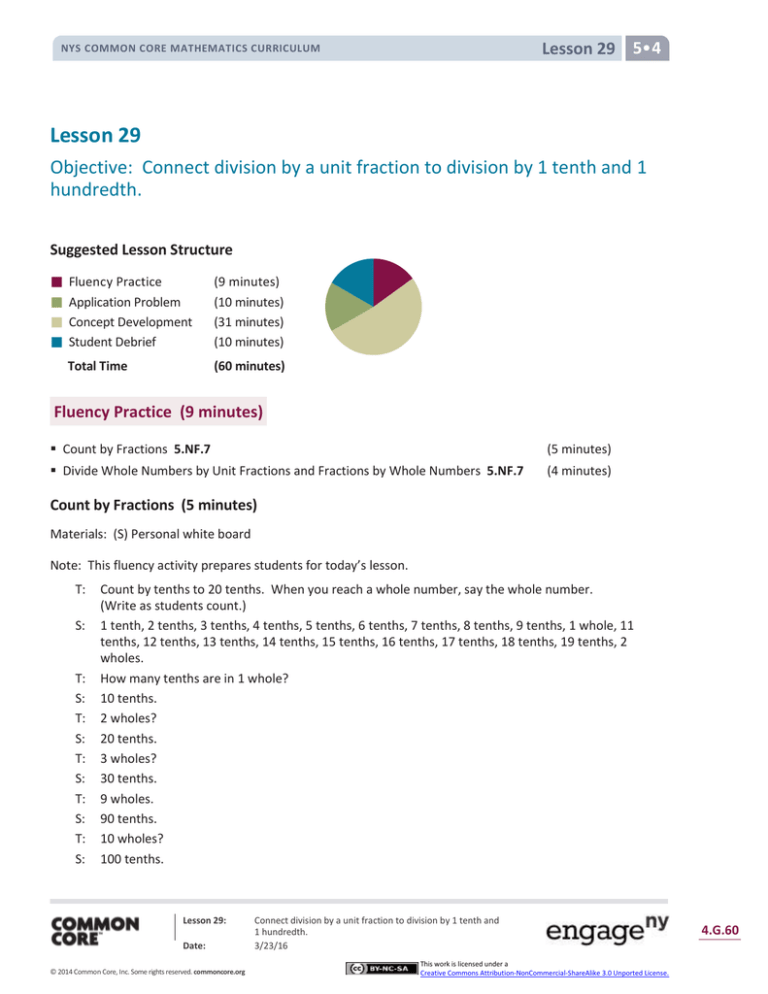
Lesson 29 5•4
NYS COMMON CORE MATHEMATICS CURRICULUM
Lesson 29
Objective: Connect division by a unit fraction to division by 1 tenth and 1
hundredth.
Suggested Lesson Structure
Fluency Practice
Application Problem
Concept Development
Student Debrief
Total Time
(9 minutes)
(10 minutes)
(31 minutes)
(10 minutes)
(60 minutes)
Fluency Practice (9 minutes)
Count by Fractions 5.NF.7
(5 minutes)
Divide Whole Numbers by Unit Fractions and Fractions by Whole Numbers 5.NF.7
(4 minutes)
Count by Fractions (5 minutes)
Materials: (S) Personal white board
Note: This fluency activity prepares students for today’s lesson.
T:
S:
T:
S:
T:
S:
T:
S:
T:
S:
T:
S:
Count by tenths to 20 tenths. When you reach a whole number, say the whole number.
(Write as students count.)
1 tenth, 2 tenths, 3 tenths, 4 tenths, 5 tenths, 6 tenths, 7 tenths, 8 tenths, 9 tenths, 1 whole, 11
tenths, 12 tenths, 13 tenths, 14 tenths, 15 tenths, 16 tenths, 17 tenths, 18 tenths, 19 tenths, 2
wholes.
How many tenths are in 1 whole?
10 tenths.
2 wholes?
20 tenths.
3 wholes?
30 tenths.
9 wholes.
90 tenths.
10 wholes?
100 tenths.
Lesson 29:
Date:
© 2014 Common Core, Inc. Some rights reserved. commoncore.org
Connect division by a unit fraction to division by 1 tenth and
1 hundredth.
3/23/16
This work is licensed under a
Creative Commons Attribution-NonCommercial-ShareAlike 3.0 Unported License.
4.G.60
Lesson 29 5•4
NYS COMMON CORE MATHEMATICS CURRICULUM
T:
S:
(Write 10 = 100 tenths. Beneath it, write 20 = ____ tenths.) On your personal white board, fill in the
unknown.
(Write 20 = 200 tenths.)
Continue the process with 30, 50, 70, and 90.
T:
S:
(Write 90 = 900 tenths. Beneath it, write 91 = ____ tenths.) On your personal white board, fill in the
unknown.
(Write 91 = 910 tenths.)
Continue the process with 92, 82, 42, 47, 64, 64.1, 64.2, and 83.5.
Divide Whole Numbers by Unit Fractions and Fractions by Whole Numbers (4 minutes)
Materials: (S) Personal white board
Note: This fluency activity reviews Lessons 25─27 and prepares students for today’s lesson.
1
T:
(Write 2 ÷ 2 .) Say the division sentence with the answer.
S:
2 ÷ 2 = 4.
T:
(Write 2 ÷ 2 = 4. Beneath it, write 3 ÷ 2 .) Say the division sentence with the answer.
S:
3 ÷ 2 = 6.
T:
(Write 3 ÷ 2 = 6. Beneath it, write 8 ÷ 2 .) On your personal white board, complete the division
1
1
1
1
1
1
sentence.
S:
1
(Write 8 ÷ 2 = 16.)
1
4
1
3
Continue the process with 5 ÷ , 7 ÷ , 1 ÷
1
,
10
2÷
1
,
10
7÷
1
10
1
T:
(Write 2 ÷ 3.) Say the division sentence with the answer.
S:
1
2
T:
S:
T:
1
10
, and 10 ÷ .
1
6
1
(Write 2 ÷
1
1
÷ 4 = 12.
3
1
(Write ÷
3
÷3= .
1
1
3 = 6. Beneath it, write 3 ÷ 4.) Say the division sentence with the answer.
1
12
1
8
4 = . Beneath it, write ÷ 5.) On your personal white board, complete the division
sentence.
1
1
S:
(Write 8 ÷ 5 = 40.)
T:
(Write ÷ 5.) Say the division sentence with the answer.
S:
1
4
÷5=
1
4
1
.
20
Lesson 29:
Date:
© 2014 Common Core, Inc. Some rights reserved. commoncore.org
Connect division by a unit fraction to division by 1 tenth and
1 hundredth.
3/23/16
This work is licensed under a
Creative Commons Attribution-NonCommercial-ShareAlike 3.0 Unported License.
4.G.61
Lesson 29 5•4
NYS COMMON CORE MATHEMATICS CURRICULUM
1
1
1 1
1
1
Continue the process with 7 ÷ 4 , 4 ÷ 7, 5 ÷ 6 , 6 ÷ 5, 8 ÷ 7, and 9 ÷ 8.
Application Problem (10 minutes)
1
Fernando bought a jacket for $185 and sold it for 1 2 times what
1
he paid. Marisol spent 5 as much as Fernando on the same
1
jacket but sold it for 2 as much as Fernando did. How much
money did Marisol make? Explain your thinking using a
diagram.
Note: This problem is a multi-step problem requiring a high
level of organization. Scaling language and fraction
multiplication from Topic G, coupled with fraction of a set and
subtraction, warrant the extra time given to today’s Application
Problem.
Concept Development (31 minutes)
Materials: (S) Personal white board
Problem 1: 7 ÷ 0.1
T:
S:
T:
(Post Problem 1 on the board.) Read the division
expression using unit form.
7 ones divided by 1 tenth.
Rewrite this expression using a fraction.
S:
(Write 7 ÷ 10.)
T:
1
7 ÷ 10.)
S:
T:
S:
1
(Write
What question does this division
expression ask us?
How many tenths are in 7? 7 is one tenth of what
number?
(Write There are ____ tenths in 1 whole.) Let’s start
with just 1 whole. How many tenths are in 1 whole?
10 tenths.
Lesson 29:
Date:
© 2014 Common Core, Inc. Some rights reserved. commoncore.org
NOTES ON
MULTIPLE MEANS
OF ACTION AND
EXPRESSION:
The same place value mats that were
used in previous modules can be used
in this lesson to support students who
are struggling. Students can start
Problem 1 by drawing or placing 7 disks
in the ones column. Teachers can
follow the same dialogue that is
written in the lesson. Have the
students physically decompose the 7
wholes into 70 tenths, which can then
be divided by one-tenth.
Connect division by a unit fraction to division by 1 tenth and
1 hundredth.
3/23/16
This work is licensed under a
Creative Commons Attribution-NonCommercial-ShareAlike 3.0 Unported License.
4.G.62
Lesson 29 5•4
NYS COMMON CORE MATHEMATICS CURRICULUM
T:
MP.2
S:
T:
S:
T:
S:
(Write 10 in the blank, and then below it write, There are _____ tenths in 7 wholes.) So, if there are
10 tenths in 1 whole, how many are in 7 wholes?
70 tenths.
(Write 70 in the blank.) Explain how you know. Turn and talk.
There are 10 tenths in 1, 20 tenths in 2, and 30 tenths in 3, so there are 70 tenths in 7. 7 is 7
times greater than 1, and 70 tenths is 7 times more than 10 tenths. Seven times 10 is 70 so there
are 70 tenths in 7.
Let’s think about it another way. 7 is one-tenth of what number? Explain to your partner how you
know.
It’s 70 because I think of a tape diagram with 10 parts, and 1 part is 7. 7 × 10 is 70. I think of
place value. Just move each digit one place to the left. It’s ten times as much.
Problem 2: 7.4 ÷ 0.1
T:
(Post Problem 2 on the board.) Rewrite
this division expression using a fraction
for the divisor.
S:
(Write 7.4 ÷ 10.)
T:
Compare this problem to the one we
just solved. What do you notice? Turn
and talk.
There still are 7 wholes, but now there are also 4 more tenths. The whole in this problem is just 4
tenths more than in problem 1. There are 74 tenths instead of 70 tenths. We can ask
ourselves, 7.4 is 1 tenth of what number?
We already know part of this problem. (Write There are _____ tenths in 7 wholes.) How many
tenths are in 7 wholes?
70.
(Write 70 in the blank, and below it, write There are _____ tenths in 4 tenths.) How many tenths are
in 4 tenths?
4.
(Point to 7 ones.) So, if there are 70 tenths in 7 wholes, and (point to 4 tenths) 4 tenths in 4 tenths,
how many tenths are in 7 and 4 tenths?
74.
Work with your partner to rewrite this expression using only tenths to name the whole and divisor.
(Write 74 tenths ÷ 1 tenth.)
Look at our new expression. How many tenths are in 74 tenths?
74 tenths.
(Write 6 ÷ 0.1.) Read this expression.
6 divided by 1 tenth.
How many tenths are in 6? Show me on your personal white board.
S:
T:
S:
T:
S:
T:
S:
T:
S:
T:
S:
T:
S:
T:
1
Lesson 29:
Date:
© 2014 Common Core, Inc. Some rights reserved. commoncore.org
Connect division by a unit fraction to division by 1 tenth and
1 hundredth.
3/23/16
This work is licensed under a
Creative Commons Attribution-NonCommercial-ShareAlike 3.0 Unported License.
4.G.63
Lesson 29 5•4
NYS COMMON CORE MATHEMATICS CURRICULUM
S:
T:
S:
T:
S:
T:
S:
(Write and show 60 tenths.)
6 is 1 tenth of what number?
60.
(Erase 6 and replace with 6.2.) How many tenths in 6.2?
(Write 62 tenths.)
6.2 is 1 tenth of what number?
62.
Continue the process with 9 ÷ 0.1, 9.8 ÷ 0.1, 12 ÷ 0.1, and 12.6 ÷ 0.1.
Problem 3:
T:
S:
T:
a. 7 ÷ 0.01
b. 7.4 ÷ 0.01
c. 7.49 ÷ 0.01
(Post Problem 3 (a) on the board.) Read this
expression.
7 divided by 1 hundredth.
Rewrite this division expression using a fraction for the
divisor.
1
S:
(Write 7 ÷ 100.)
T:
We can think of this as finding how many hundredths
are in 7. Will your thinking need to change to solve this? Turn and talk.
No, because the question is really the same. How
many smaller units are in the whole? The units we
are counting are different, but that doesn’t really
NOTES ON
change how we find the answer.
MULTIPLE MEANS
Will our quotient be greater or less than our last
OF REPRESENTATION:
problem? Again, talk with your partner.
Generally speaking, it is better for
The quotient will be greater because we are counting
teachers to use unit form when they
read decimal numbers. For example,
units that are much smaller, so there’ll be more of
seven and four-tenths is generally
them in the wholes. It’s the same basic idea, but
preferable to seven point four. Seven
since our divisor has gotten smaller, the quotient
point four is appropriate when
should be larger than before.
teachers or students are trying to
Before we think about how many hundredths are in 7
express what they need to write.
wholes, let’s find how many hundredths are in 1 whole.
Similarly, it is preferable to read
fractions in unit form, too. For
(Write on the board: There are _____ hundredths in 1
example, it’s better to say two-thirds,
whole.) Fill in the blank.
rather than two over three unless
100.
referring to how the fraction is written.
(Write 100 in the blank. Write, There are _____
hundredths in 7 wholes.) Knowing this, how many
hundredths are in 7 wholes?
700.
S:
T:
S:
T:
S:
T:
S:
Lesson 29:
Date:
© 2014 Common Core, Inc. Some rights reserved. commoncore.org
Connect division by a unit fraction to division by 1 tenth and
1 hundredth.
3/23/16
This work is licensed under a
Creative Commons Attribution-NonCommercial-ShareAlike 3.0 Unported License.
4.G.64
Lesson 29 5•4
NYS COMMON CORE MATHEMATICS CURRICULUM
T:
S:
T:
S:
T:
S:
T:
S:
T:
S:
T:
S:
T:
S:
T:
S:
MP.2
T:
S:
T:
S:
T:
S:
T:
S:
T:
S:
T:
S:
(Write 700 in the blank. Then, post Problem 3 (b) on the board.) What is the whole in this division
expression?
7 and 4 tenths.
How will you solve this problem? Turn and talk.
It’s only 4 more tenths than the one we just solved. We
need to figure out how many hundredths are in 4 tenths.
We know there are 700 hundredths in 7 wholes, and this
is 4 tenths more than that. There are 10 hundredths in 1
tenth so there must be 40 hundredths in 4 tenths.
How many hundredths are in 7 wholes?
700.
How many hundredths in 4 tenths?
40.
How many hundredths in 7.4?
740.
Asked another way, if 7.4 is 1 hundredth, what is the whole?
740.
(Post Problem 3 (c) on the board.) Work with a partner to
solve this problem. Be prepared to explain your thinking.
(Work and show 7.49 ÷ 0.01 = 749.)
Explain your thinking as you solved.
7.49 is just 9 hundredths more in the dividend than 7.4 ÷
0.01, so the answer must be 749. There are 700
hundredths in 7, and 49 hundredths in 49 hundredths.
That’s 749 hundredths all together.
Let’s try some more. Think first... how many hundredths are in 6? Show me.
(Show 600.)
Show me how many hundredths are in 6.2?
(Show 620.)
6.02?
(Show 602.)
12.6?
(Show 1,260.)
12.69?
(Show 1,269.)
What patterns are you noticing as we find the number of hundredths in each of these quantities?
The digits stay the same, but they are in a larger place value in the quotient. I’m beginning to
notice that, when we divide by a hundredth, each digit shifts two places to the left. It’s like
multiplying by 100.
Lesson 29:
Date:
© 2014 Common Core, Inc. Some rights reserved. commoncore.org
Connect division by a unit fraction to division by 1 tenth and
1 hundredth.
3/23/16
This work is licensed under a
Creative Commons Attribution-NonCommercial-ShareAlike 3.0 Unported License.
4.G.65
Lesson 29 5•4
NYS COMMON CORE MATHEMATICS CURRICULUM
MP.2
T:
That helps us think of our division expression differently. When we divide by a hundredth, we can
think, “This number is 1 hundredth of what whole?” or “What number is this 1 hundredth of?”
T:
(Write 7 ÷ 100 on the board.) What number is 7 one hundredths of?
S:
T:
S:
700.
Explain to your partner how you know.
It’s like thinking 7 times 100 because 7 is one of a hundred parts. It’s place value again, but this
time, the digits shifted two places to the right.
You can use that way of thinking about these expressions, too.
T:
1
Problem Set (10 minutes)
Students should do their personal best to complete the Problem Set within the allotted 10 minutes. For some
classes, it may be appropriate to modify the assignment by specifying which problems they work on first.
Some problems do not specify a method for solving. Students should solve these problems using the RDW
approach used for Application Problems.
Student Debrief (10 minutes)
Lesson Objective: Connect division by a unit fraction to
division by 1 tenth and 1 hundredth.
The Student Debrief is intended to invite reflection and
active processing of the total lesson experience.
Invite students to review their solutions for the Problem
Set. They should check work by comparing answers with a
partner before going over answers as a class. Look for
misconceptions or misunderstandings that can be
addressed in the Debrief. Guide students in a
conversation to debrief the Problem Set and process the
lesson.
You may choose to use any combination of the questions
below to lead the discussion.
In Problem 1, did you notice the relationship
between (a) and (c), (b) and (d), (e) and (g), (f)
and (h)?
What is the relationship between Problems 2(a)
and 2(b)? (The quotient of (b) is triple that of (a).)
What strategy did you use to solve Problem 3? Share your strategy and explain to a partner.
How did you answer Problem 4? Share your thinking with a partner.
Lesson 29:
Date:
© 2014 Common Core, Inc. Some rights reserved. commoncore.org
Connect division by a unit fraction to division by 1 tenth and
1 hundredth.
3/23/16
This work is licensed under a
Creative Commons Attribution-NonCommercial-ShareAlike 3.0 Unported License.
4.G.66
Lesson 29 5•4
NYS COMMON CORE MATHEMATICS CURRICULUM
Compare your answer for Problem 5 to your
partner’s.
Connect the work of Module 1, the movement on
the place value chart, to the division work of this
lesson. (Back then, the focus was on conversion
between units. However, it’s important to note
that place value work asks the same questions,
“How many tenths are in 1 whole?” “How many
hundredths are in a tenth?” Further, the partitive
division interpretation leads naturally to a
discussion of multiplication by powers of 10. That
is, if 6 is 1 hundredth, what is the whole? (6 × 100
= 600.) This echoes the work students have done
on the place value chart.)
Exit Ticket (3 minutes)
After the Student Debrief, instruct students to complete
the Exit Ticket. A review of their work will help you assess
the students’ understanding of the concepts that were
presented in the lesson today and plan more effectively for
future lessons. You may read the questions aloud to the
students.
Lesson 29:
Date:
© 2014 Common Core, Inc. Some rights reserved. commoncore.org
Connect division by a unit fraction to division by 1 tenth and
1 hundredth.
3/23/16
This work is licensed under a
Creative Commons Attribution-NonCommercial-ShareAlike 3.0 Unported License.
4.G.67
Lesson 29 Problem Set 5•4
NYS COMMON CORE MATHEMATICS CURRICULUM
Name
Date
1. Divide. Rewrite each expression as a division sentence with a fraction divisor, and fill in the blanks.
The first one is done for you.
Example:
1
2 ÷ 0.1 = 2 ÷ 10 = 20
a. 5 ÷ 0.1 =
There are
10
tenths in 1 whole.
There are
20
tenths in 2 wholes.
b. 8 ÷ 0.1 =
There are
tenths in 1 whole.
There are
tenths in 1 whole.
There are
tenths in 5 wholes.
There are
tenths in 8 wholes.
d. 8.7 ÷ 0.1 =
c. 5.2 ÷ 0.1 =
There are
tenths in 5 wholes.
There are
tenths in 8 wholes.
There are
tenths in 2 tenths.
There are
tenths in 7 tenths.
There are
tenths in 5.2
There are
tenths in 8.7
e. 5 ÷ 0.01 =
f. 8 ÷ 0.01 =
There are
hundredths in 1 whole.
There are
hundredths in 1 whole.
There are
hundredths in 5 wholes.
There are
hundredths in 8 wholes.
g. 5.2 ÷ 0.01 =
h. 8.7 ÷ 0.01 =
There are
hundredths in 5 wholes.
There are
hundredths in 8 wholes.
There are
hundredths in 2 tenths.
There are
hundredths in 7 tenths.
There are
hundredths in 5.2
There are
hundredths in 8.7
Lesson 29:
Date:
© 2014 Common Core, Inc. Some rights reserved. commoncore.org
Connect division by a unit fraction to division by 1 tenth and
1 hundredth.
3/23/16
This work is licensed under a
Creative Commons Attribution-NonCommercial-ShareAlike 3.0 Unported License.
4.G.68
NYS COMMON CORE MATHEMATICS CURRICULUM
2. Divide.
a. 6 ÷ 0.1
Lesson 29 Problem Set 5•4
b. 18 ÷ 0.1
c. 6 ÷ 0.01
d. 1.7 ÷ 0.1
e. 31 ÷ 0.01
f.
11 ÷ 0.01
g. 125 ÷ 0.1
h. 3.74 ÷ 0.01
i.
12.5 ÷ 0.01
3. Yung bought $4.60 worth of bubble gum. Each piece of gum cost $0.10. How many pieces of bubble gum
did Yung buy?
4. Cheryl solved a problem: 84 ÷ 0.01 = 8,400.
Jane said, “Your answer is wrong because when you divide, the quotient is always smaller than the whole
amount you start with, for example, 6 ÷ 2 = 3 and 100 ÷ 4 = 25.” Who is correct? Explain your thinking.
5. The U.S. Mint sells 2 ounces of American Eagle gold coins to a collector. Each coin weighs one-tenth of an
ounce. How many gold coins were sold to the collector?
Lesson 29:
Date:
© 2014 Common Core, Inc. Some rights reserved. commoncore.org
Connect division by a unit fraction to division by 1 tenth and
1 hundredth.
3/23/16
This work is licensed under a
Creative Commons Attribution-NonCommercial-ShareAlike 3.0 Unported License.
4.G.69
Lesson 29 Exit Ticket 5•4
NYS COMMON CORE MATHEMATICS CURRICULUM
Name
Date
1. 8.3 is equal to
2. 28 is equal to
_______ tenths
_______ hundredths
_______ hundredths
_______ tenths
3. 15.09 ÷ 0.01 = _______
1
4. 267.4 ÷ 10 = _______
1
5. 632.98 ÷ 100 = _______
Lesson 29:
Date:
© 2014 Common Core, Inc. Some rights reserved. commoncore.org
Connect division by a unit fraction to division by 1 tenth and
1 hundredth.
3/23/16
This work is licensed under a
Creative Commons Attribution-NonCommercial-ShareAlike 3.0 Unported License.
4.G.70
Lesson 29 Homework 5•4
NYS COMMON CORE MATHEMATICS CURRICULUM
Name
Date
1. Divide. Rewrite each expression as a division sentence with a fraction divisor, and fill in the blanks. The
first one is done for you.
Example:
1
4 ÷ 0.1 = 4 ÷ 10 = 40
a. 9 ÷ 0.1 =
There are
10 tenths in 1 whole.
There are
40
There are
÷ 0.1 in
= 4 wholes.
40 b. 6tenths
tenths in 4 wholes.
There are ______ tenths in 1 whole.
There are ______ tenths in 1 whole.
There are ______ tenths in 9 wholes.
There are ______ tenths in 6 wholes.
c. 3.6 ÷ 0.1 =
d. 12.8 ÷ 0.1 =
There are ______ tenths in 3 wholes.
There are ______ tenths in 12 wholes.
There are ______ tenths in 6 tenths.
There are ______ tenths in 8 tenths.
There are ______ tenths in 3.6.
There are ______ tenths in 12.8.
e. 3 ÷ 0.01 =
f. 7 ÷ 0.01 =
There are ______ hundredths in 1 whole.
There are ______ hundredths in 1 whole.
There are ______ hundredths in 3 wholes.
There are ______ hundredths in 7 wholes.
g. 4.7 ÷ 0.01 =
h. 11.3 ÷ 0.01 =
There are ______ hundredths in 4 wholes.
There are ______ hundredths in 11 wholes.
There are ______ hundredths in 7 tenths.
There are ______ hundredths in 3 tenths.
There are ______ hundredths in 4.7.
There are ______ hundredths in 11.3.
Lesson 29:
Date:
© 2014 Common Core, Inc. Some rights reserved. commoncore.org
Connect division by a unit fraction to division by 1 tenth and
1 hundredth.
3/23/16
This work is licensed under a
Creative Commons Attribution-NonCommercial-ShareAlike 3.0 Unported License.
4.G.71
Lesson 29 Homework 5•4
NYS COMMON CORE MATHEMATICS CURRICULUM
2. Divide.
a. 2 ÷ 0.1
b. 23 ÷ 0.1
c. 5 ÷ 0.01
d. 7.2 ÷ 0.1
e. 51 ÷ 0.01
f.
31 ÷ 0.1
g. 231 ÷ 0.1
h. 4.37 ÷ 0.01
i.
24.5 ÷ 0.01
3. Giovanna is charged $0.01 for each text message she sends. Last month, her cell phone bill included a
$12.60 charge for text messages. How many text messages did Giovanna send?
4. Geraldine solved a problem: 68.5 ÷ 0.01 = 6,850.
Ralph said, “This is wrong because a quotient can’t be greater than the whole you start with. For
example, 8 ÷ 2 = 4 and 250 ÷ 5 = 50.” Who is correct? Explain your thinking.
5. The price for an ounce of gold on September 23, 2013, was $1,326.40. A group of 10 friends decide to
equally share the cost of 1 ounce of gold. How much money will each friend pay?
Lesson 29:
Date:
© 2014 Common Core, Inc. Some rights reserved. commoncore.org
Connect division by a unit fraction to division by 1 tenth and
1 hundredth.
3/23/16
This work is licensed under a
Creative Commons Attribution-NonCommercial-ShareAlike 3.0 Unported License.
4.G.72


